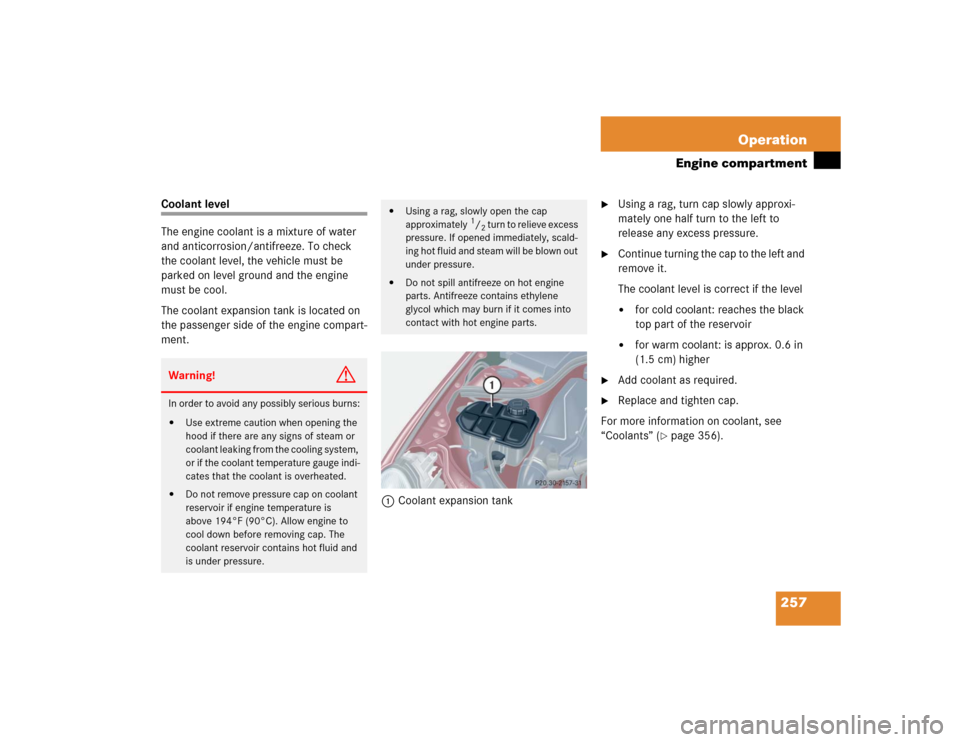Page 251 of 400

251 Operation
At the gas station
Check regularly and before a long trip
1Coolant level
For more information on coolant, see
“Coolant level” (
�page 257).
2Brake fluid (fuse box cover removed)
Removing fuse box cover
(
�page 333).
3Windshield washer and headlamp
cleaning system*
For more information on filling up the
washer reservoir, see “Windshield
washer system and headlamp cleaning
system*” (
�page 259).Engine oil level
For more information on engine oil level,
see “Engine oil” (
�page 253).
Opening hood (
�page 252).
Vehicle lighting
Check function and cleanliness. For more
information on replacing light bulbs, see
“Replacing bulbs” (�page 310).
Exterior lamp switch (�page 102).
Tire inflation pressure
More information on tire inflation pressure
(
�page 261).
!If you find that the brake fluid in the
brake fluid reservoir has fallen to the
minimum mark or below, have the
brake system checked for brake pad
thickness and leaks immediately.
Notify an authorized Mercedes-Benz
Center immediately. Do not add brake
fluid as this will not solve the problem.
For more information, see “Practical
hints” (
�page 275).
Page 257 of 400

257 Operation
Engine compartment
Coolant level
The engine coolant is a mixture of water
and anticorrosion/antifreeze. To check
the coolant level, the vehicle must be
parked on level ground and the engine
must be cool.
The coolant expansion tank is located on
the passenger side of the engine compart-
ment.
1Coolant expansion tank
�
Using a rag, turn cap slowly approxi-
mately one half turn to the left to
release any excess pressure.
�
Continue turning the cap to the left and
remove it.
The coolant level is correct if the level �
for cold coolant: reaches the black
top part of the reservoir
�
for warm coolant: is approx. 0.6 in
(1.5 cm) higher
�
Add coolant as required.
�
Replace and tighten cap.
For more information on coolant, see
“Coolants” (
�page 356).
Warning!
G
In order to avoid any possibly serious burns:�
Use extreme caution when opening the
hood if there are any signs of steam or
coolant leaking from the cooling system,
or if the coolant temperature gauge indi-
cates that the coolant is overheated.
�
Do not remove pressure cap on coolant
reservoir if engine temperature is
above 194°F (90°C). Allow engine to
cool down before removing cap. The
coolant reservoir contains hot fluid and
is under pressure.
�
Using a rag, slowly open the cap
approximately
1/2 turn to relieve excess
pressure. If opened immediately, scald-
ing hot fluid and steam will be blown out
under pressure.
�
Do not spill antifreeze on hot engine
parts. Antifreeze contains ethylene
glycol which may burn if it comes into
contact with hot engine parts.
Page 358 of 400

358 Technical dataFuels, coolants, lubricants, etc.Windshield washer and headlamp cleaning* system
Both the windshield and headlamp washer
systems are supplied from the windshield
washer fluid reservoir.
The washer fluid reservoir has a capacity of
approx.:�
3.2 US qt (3.0 l) in vehicles without
headlamp cleaning system*
�
6.4 US qt (6.0 l) in vehicles with
headlamp cleaning system*
�
Refill the reservoir with MB Windshield
Washer Concentrate “S” and water
(or concentrate and commercially
available premixed windshield washer
solvent/antifreeze, depending on
ambient temperatures).Windshield and headlamp washer fluid
mixing ratio
For temperatures above freezing, use
MB Windshield Washer Concentrate “S”
and water:
�
1 part “S” to 100 parts water
[40 ml “S” to 1 gallon (4.0 liters) water]
For temperatures below freezing, use
MB Windshield Washer Concentrate “S”
and commercially available premixed
windshield washer solvent/antifreeze:
�
1 part “S” to 100 parts solvent
[40 ml “S” to 1 gallon (4.0 liters) solvent]
Warning!
G
Washer solvent/antifreeze is highly flamma-
ble. Do not spill washer solvent/antifreeze
on hot engine parts, because it may ignite
and burn. You could be seriously burned.